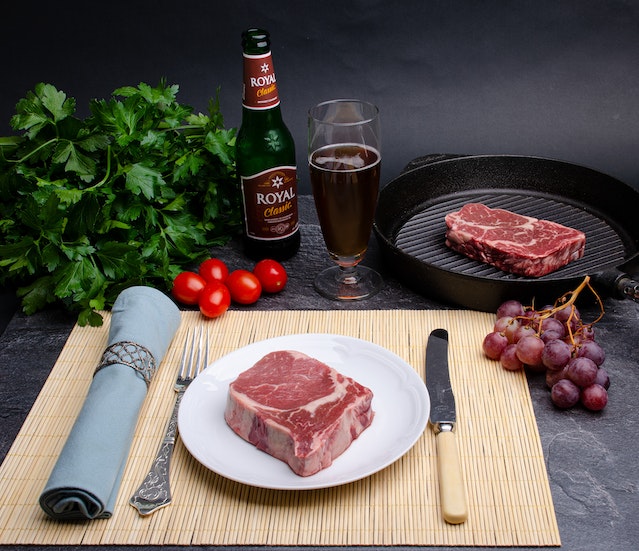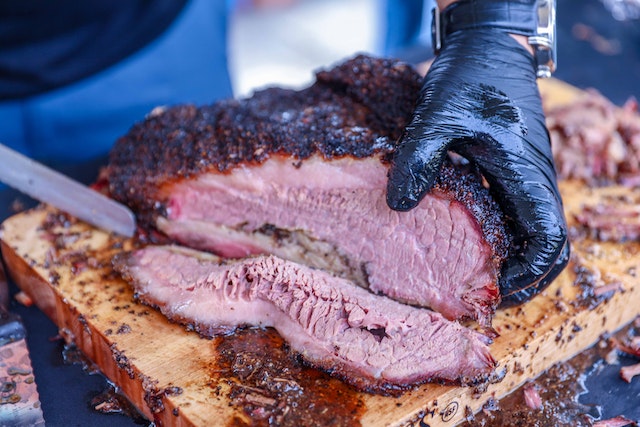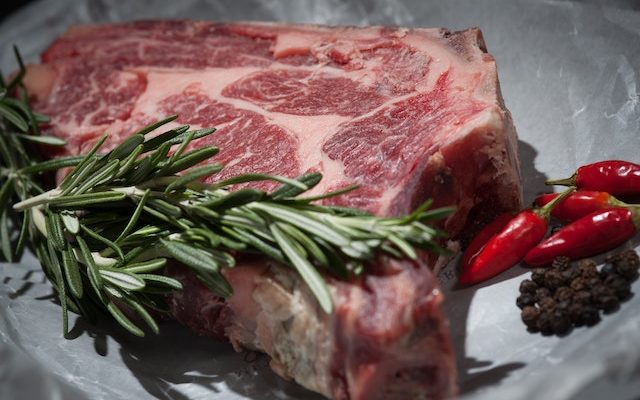Do you find yourself stumped trying to decide between a shoulder roast vs chuck roast for your next meal? With so many cuts of meat available, it’s hard to know which one will give you the best flavor and experience. But have no fear! This blog post is here to take the guesswork out of deciding what cut of beef is right for you. We’ll go over the differences between shoulder roast vs. chuck roast, helping you understand which one works best for the recipes and meal ideas that match your tastes. Read on as we dive into this flavorful topic!
Table of Contents
What Is Shoulder Roast?
Shoulder roast is a cut of beef that comes from the front shoulder area of the cow. It typically weighs in between six and eight pounds, making it an ideal family-sized dinner meal. It’s a great way to feed a large group or have leftovers for future meals. Shoulder roast has a rich flavor and can be cooked using various methods such as slow roasting, braising, and grilling. When properly cooked, the meat should be juicy on the inside with an exterior that is slightly crispy around the edges.
Before cooking it’s important to season the roast with salt and pepper so that you can bring out its full flavor potential. For an added layer of flavor, consider adding herbs like rosemary or thyme. With the right ingredients and preparation, shoulder roast can make a delicious meal that your family will love.
To ensure that your shoulder roast turns out perfectly cooked, it’s important to pay attention to the temperature when roasting it in the oven. The ideal internal temperature should be between 125-130°F for medium rare or 130-140°F for medium. Use a digital thermometer to accurately measure the internal temp of the meat and take it out of the oven as soon as it reaches your desired doneness. Letting it rest for 10 minutes before slicing is also recommended to lock in its juices. Once you’ve taken all these steps, you’re ready to enjoy an amazing dinner with your favorite sides!
What Are The Key Features To Look For In A Shoulder Roast?

When preparing a shoulder roast, there are several key features you should look for in order to ensure optimal flavor and texture. Here is a short list of what to pay attention to:
– Cut: Shoulder roast comes from the chuck or neck area of the cow and is traditionally cut into thick slices with plenty of marbling. Look for cuts that have good marbling throughout, as this adds flavor while also helping it stay moist during cooking.
– Fat: Shoulder roasts contain more fat than other beef cuts, so you will want to look for pieces with visible fat on them for best results. The extra fat helps keep the meat tender and juicy when cooked slowly over low heat.
– Size: Shoulder roasts can come in a variety of sizes, ranging from four to eight pounds. When selecting your roast, make sure to pay attention to the size and pick one that will fit your needs.
– Quality: Look for high quality beef with plenty of marbling and no visible signs of discoloration or bruising. This ensures that you get the best tasting roast possible.
By taking the time to select a shoulder roast according to these criteria, you can guarantee that your meal will be tender, juicy, and full of flavor!
What Is Chuck Roast?
Chuck roast is a cut of beef that comes from the shoulder. It is relatively inexpensive, making it a popular choice for slow cooking in stews and soups. Chuck roast has rich, marbling throughout the meat, giving it an intense flavor when cooked. This cut of beef absorbs flavors well and is great on its own with herbs and spices or combined in dishes with vegetables and sauces. When cooked low and slow, chuck roast can be incredibly tender and moist. It’s an excellent option for meals large enough to feed many people at once. With proper preparation, chuck roast can make a flavorful addition to any meal.
What Are The Key Features To Look For In A Chuck Roast?

When shopping for a chuck roast, there are several key features to look for that will help ensure you get the best quality cut of meat.
– Fat Content: A good quality chuck roast should have an even distribution of fat running throughout the meat. This fat helps keep the roast tender and moist when cooked.
– Marbling: Marbling, or small flecks of white fat within the red muscle, is also an indication of high-quality beef and adds flavor to the finished product.
– Uniformity: Look for a chuck roast with uniform thickness so it cooks evenly and stays juicy throughout cooking time.
– Age: Beef labeled as “choice” grade should be no more than 8-10 weeks old, while “prime” grade should be no more than 6 weeks old. The younger the beef, the higher the quality and better flavor it will have.
– Color: A good quality chuck roast should be bright red in color with a deep purple hue. If the roast is grayish or dull in color, this indicates that it may not be fresh or of high-quality.
By keeping these features in mind when purchasing a chuck roast, you can ensure you are getting a cut of meat that is flavorful and of high-quality.
Shoulder Roast vs Chuck Roast Comparison
A shoulder roast and a chuck roast are two different cuts of beef that are often used to make the same types of dishes. Although they both come from the shoulder area, there are some key differences between them. Here is a list of how these cuts compare:
– Taste and Texture: The shoulder roast typically has a richer flavor than the chuck roast due to its higher marbling content. It also tends to be a bit more tender since it is taken from an area closer to the rib where muscles do not work as hard. Chuck roasts, on the other hand, have less fat and tend to be tougher due to their location further down in the shoulder where muscles can get worked more often.
– Fat Content: Shoulder roasts have more fat marbling in them, which adds to their flavor but also makes them higher in calories. Chuck roasts typically have less marbling and are considered a leaner cut of beef.
– Cost: Shoulder roasts tend to cost more than chuck roasts because of the extra fat content that adds flavor. Chuck roasts are usually cheaper and may be a better option for those looking to save money.
– Cooking Time: Because of the difference in texture and fat content, shoulder roast will require longer cooking times than chuck roast due to its tougher nature. It is important to not overcook either type of meat since they can both dry out quickly if cooked too long.
Both shoulder roasts and chuck roasts are delicious cuts of beef that can be used to make a variety of dishes. By understanding the key differences between them, you can choose the right cut for your needs.
>>> Read more:
Best Electric Smokers Consumer Reports
FAQs About Shoulder Roast vs Chuck Roast
Can You Use A Shoulder Roast In Place Of A Chuck Roast?
Yes, you can use a shoulder roast in place of a chuck roast. The two are very similar cuts and a shoulder roast will have the same amount of fat marbling and flavor as a chuck. However, because the shoulder is slightly leaner than the chuck, it may cook faster so keep an eye on it while it is in the oven. Additionally, since the shoulder has more connective tissue than other cuts from this muscle group, be sure to slow-cook over low heat for maximum tenderness.
Can You Overcook A Beef Shoulder Roast?

Yes, it is possible to overcook a beef shoulder roast. This is especially true if using a slow cooking method. When a roast is cooked for too long, the meat can become dry and tough due to the natural fats and proteins breaking down over time. This can result in an unpleasant eating experience as the beef will be difficult to chew and swallow.
When slow-cooking a beef shoulder roast, it’s important to keep an eye on the internal temperature of the meat. It should reach at least 145 degrees Fahrenheit (63 Celsius) in order for it to be considered safe to eat. Any lower than that and bacteria may still be present in the meat, posing a potential health risk. If you’re unsure of how long your roast has been cooking, you can use a kitchen thermometer inserted into the thickest part of the meat and read off its internal temperature; this will give you an indication of whether or not it’s ready yet.
In addition to checking the internal temperature with a thermometer, another way to gauge if your roast is done is by cutting into it with a sharp knife. You’ll be able to tell if it’s done by looking at how dark or light the juices are running from your cut pieces – clear juices indicate that the roast is still underdone, while darker juices mean that it’s cooked all the way through.
How Do You Soften A Shoulder Roast?
To soften a shoulder roast, season it with salt and pepper, then rub it down with olive oil and herbs. Place the roast in a roasting pan, add some liquid (such as broth or beer), cover tightly with foil and bake at 350 degrees Fahrenheit for approximately two hours. For extra tenderness, you can use a slow cooker set to low heat and cook your shoulder roast for 8-10 hours. When finished cooking, let rest before slicing and serving.
What Is The Difference Between A Shoulder Roast And Other Cuts Of Beef?
A shoulder roast comes from the chuck section of the cow, which is located near the neck and shoulders. The marbling in this cut of meat helps to keep it tender while cooking, making it ideal for slow-cooking recipes and roasting.
How Do I Store My Shoulder Roast?
For optimal freshness, you should wrap your shoulder roast tightly in plastic wrap or butcher paper before storing it in the refrigerator, where it will remain fresh for up to five days.
How Should I Prepare A Shoulder Roast?
A shoulder roast should be thawed overnight in the refrigerator before cooking. When ready to cook, pat the roast dry with paper towels and season it liberally with salt, pepper, garlic powder and other spices of your choice. For best results, sear all sides of the meat in a hot pan before transferring it to an oven-proof dish and roasting at 350°F (175°C) until cooked through.
What Is The Ideal Internal Temperature For A Shoulder Roast?
When cooking beef, it’s important to ensure that it reaches an internal temperature of at least 145°F (63°C). Use a meat thermometer to check that the roast is cooked properly before serving.
How Long Should I Cook A Shoulder Roast?
The time needed to cook a shoulder roast will vary depending on its size and the cooking method used. Generally, it takes around an hour for 3-4 pounds of meat cooked in the oven at 350°F (175°C). A smaller cut may take less time, while larger roasts can take up to two hours. Be sure to use a meat thermometer to check for doneness.
What Is The Best Way To Cook Chuck Roast?
The best way to cook chuck roast is by slow-cooking it in liquid such as stock or broth at low temperatures for several hours, until it’s tender and cooked through. This can be done on the stovetop or in a slow cooker.
How Long Should I Cook My Chuck Roast?
The amount of time required to cook your chuck roast will vary depending on its size and the cooking method used. As a general guideline, it is recommended to cook chuck roast at a low temperature of around 225-275°F, for approximately 2-3 hours per pound.
What Can I Serve With My Chuck Roast?

Chuck roast pairs well with many side dishes such as potatoes, carrots, onions, and mushrooms. Roast vegetables are also great accompaniments for this dish and can be cooked alongside the meat in the same roasting pan or slow cooker.
Is Chuck Roast Healthy?
Yes! Chuck roast is rich in protein and contains essential vitamins and minerals such as iron, zinc, phosphorus, selenium, vitamin B12 and niacin. It also contains healthy fats which can help keep you fuller for longer and provide added energy.
How Can I Store Leftover Chuck Roast?
Leftover cooked chuck roast should be cooled quickly and stored in an airtight container or zip-top bag in the refrigerator. It will stay fresh for up to four days. Cooked chuck roast can also be frozen for longer storage; however, it is best to consume it within three months of freezing.
Conclusion
All in all, both the chuck roast and shoulder roast are great options for a hearty winter meal. The Chuck Roast is slightly less expensive and has more fat content, making it ideal for those who like their meat a little juicier. Shoulder Roast is leaner but tougher, so it’s perfect for slow cooking to help break down the tough fibers. No matter which one you choose, you’re sure to enjoy a delicious winter meal!
Cafe Toscana Restaurant blog is all about good food, great coffee and wonderful company. We strive to bring you the best of everything, and our blog posts reflect that commitment. Whether it’s a new recipe, a review of a local coffee shop or an update on our latest specials, we hope you’ll find something to enjoy here. Thanks for stopping by!
>>> See more: Roast Lamb Shoulder – Perfect Sunday Roast!

